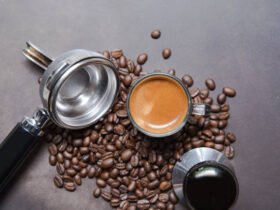Are you stuck somewhere without a coffee maker? Do not be worried; there are other techniques. We’ll look at three easy methods in this guide to prepare coffee without a typical coffee machine.

People brewed coffee for millennia before the invention of contemporary machinery. Coffee preparation has a long history, ranging from the simple “cowboy coffee” prepared over open fires with simple utensils to the sophisticated Turkish coffee served in elaborate cups. With a little imagination and initiative, you can use ground coffee and common kitchen supplies to make a delicious cup of coffee. It will taste and smell familiar, and it will also provide you the much-needed caffeine boost.
Method #1: Cowboy Coffee
First up, let’s explore the classic method. Picture yourself stranded in the wilderness, surrounded only by the glow of the night sky and a crackling campfire. Armed with just a knapsack’s worth of materials and nature’s elements, how does a caffeine-craving cowboy cope? The answer lies in getting resourceful. Essentially, this method involves boiling coffee over an open fire using a pot. The most crucial aspect? Your willingness to persevere through potential frustrations and, of course, paying close attention to the process.
WHAT YOU’LL NEED
- A pot or saucepan
- A measuring cup
- A spoon
- A ladle or strainer (optional)
First, measure out your desired amount of cold water.
If you’re brewing a single cup for yourself, stick to the standard measurement of 12 ounces. Additionally, fill the measuring cup to about 13 ounces to accommodate evaporation and coffee absorption.
Measure your desired amount of ground coffee.
Measure your desired amount of ground coffee, aiming for about one tablespoon of grounds per 5 ounces of water.
Set the saucepan over medium-high heat on a stovetop
Set the saucepan over medium-high heat on a stovetop (or over an open flame – use your judgment on that one, cowboy), and bring the combination to a boil.
About 45 seconds after boiling, stir the mixture.
use your judgment on that one, cowboy), and bring the combination to a boil.
After two minutes of boiling, uncovered, remove the mixture from heat. Grinds should sink to the bottom. Let the mixture continue to brew for approximately three minutes.
Finally, pour the coffee into a cup. Use a ladle or a strainer to ensure your cup is not filled with unwanted grinds. Pour and enjoy!
Method #2: Turkish Coffee
Turkish coffee is not a specific coffee variety, but rather a method of preparation. This technique is particularly popular in Arab countries like Yemen and various Eastern European regions. Interestingly, it holds cultural significance, often observed during Turkish marital rituals as couples assess their compatibility. Despite its simplicity, Turkish coffee offers an elegant brewing process that yields a delightful cup of coffee. Even for those who possess more conventional brewing equipment like a Chemex or French Press, indulging in Turkish coffee is a delightful experience. Additionally, its small serving size makes it incredibly efficient, providing not only a satisfying coffee flavor but also a taste of cultural tradition.
WHAT YOU’LL NEED
- A very small pot
- A measuring cup
- A spoon
Method #3: The “Bag It” Method
Despite the perception of requiring more effort, this method is surprisingly simple and yields a much better-tasting brew. The filter effectively prevents bitterness, distinguishing it from methods like the cowboy coffee technique described earlier. Think of it as akin to brewing tea, but for coffee. In this scenario, a simple filter emerges as the most portable coffee maker available. If you’re embarking on a trip and uncertain whether your destination will have a coffee maker (whether it’s your in-laws’ home, a campground, or your sparsely equipped apartment), it might be wise to bring along some filters as a backup. You’ll appreciate the foresight, and your adept use of a filter and string may even earn you some admiration from onlookers.
WHAT YOU’LL NEED
- A filter
- String
- A keetle or pot
- A measuring cup
Spread out the filter on a flat surface and add your preferred amount of coffee onto it – typically about two-and-a-half tablespoons for a single cup. Fold the ends of the filter over the coffee and tie them securely, ensuring there are no openings for the grounds to escape. The resulting product should resemble a dumpling or a makeshift tea bag. Submerge the “dumpling” into a cup.
Meanwhile, heat water until it reaches a boil, either using a kettle or a pot. For optimal flavor, pour enough water over the coffee bag to saturate the grounds, allowing them to soak for about 30 seconds. Then, fill the cup with the remaining hot water.
Allow the mixture to steep for approximately four minutes, or longer if you prefer a stronger brew with higher caffeine content. Once steeped to your liking, remove the coffee bag from the cup and discard it. Finally, sit back, relax, and savor your freshly brewed coffee!
The Takeaway: In a pinch, you don’t need a coffee brewer at all
However, let’s not naively imply that you’d prefer most of your roasts without a coffee brewer if given the option. Coffee making involves a delicate chemistry that considers factors such as brewing temperature, steeping time, roasting dates, and cup temperature. While the cowboy might have improvised his coffee-making method when pressed for alternatives, we often have the luxury of choice, allowing us to honor the meticulously grown and harvested coffee from around the world.





